In March 2013, the venerated BBC consolidated its news, Online, TV and Radio branches and brand new technology in London into one center, the new BBC Broadcasting House on Portland Place. All of the BBC’s newscasters came together in this new studio, now London’s headquarters.
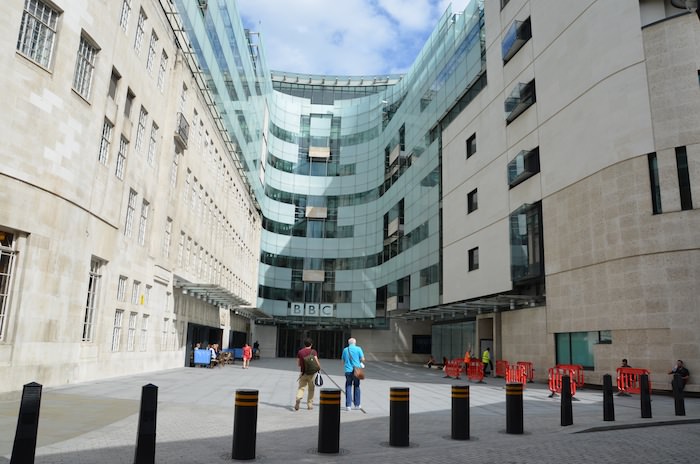
We enter the BBC Broadcasting House through a wide courtyard, thirty meters across, and 60 meters deep.
A 1.5-hour tour of this new facility is now offered, and in July I was able to squeeze this tour into my London schedule, emerging enlightened and impressed. We enter the BBC Broadcasting House through a wide courtyard, thirty meters across, and 60 meters deep. The far end of the U-shaped courtyard, or Piazza, is lined with curved green glass, with revolving door beneath. The courtyard floor is lined with concrete slabs.
After passing through a security station we assemble in a side lobby, where we meet our tour guides and receive our badges. We’re given an introduction about the BBC, its operations, and its effects on world communications. The BBC employs a staff of 24,000 globally, spread out in 50 bureaus. It’s certainly grown a lot. Compare this figure with the 400 people who worked for the company in 1932.
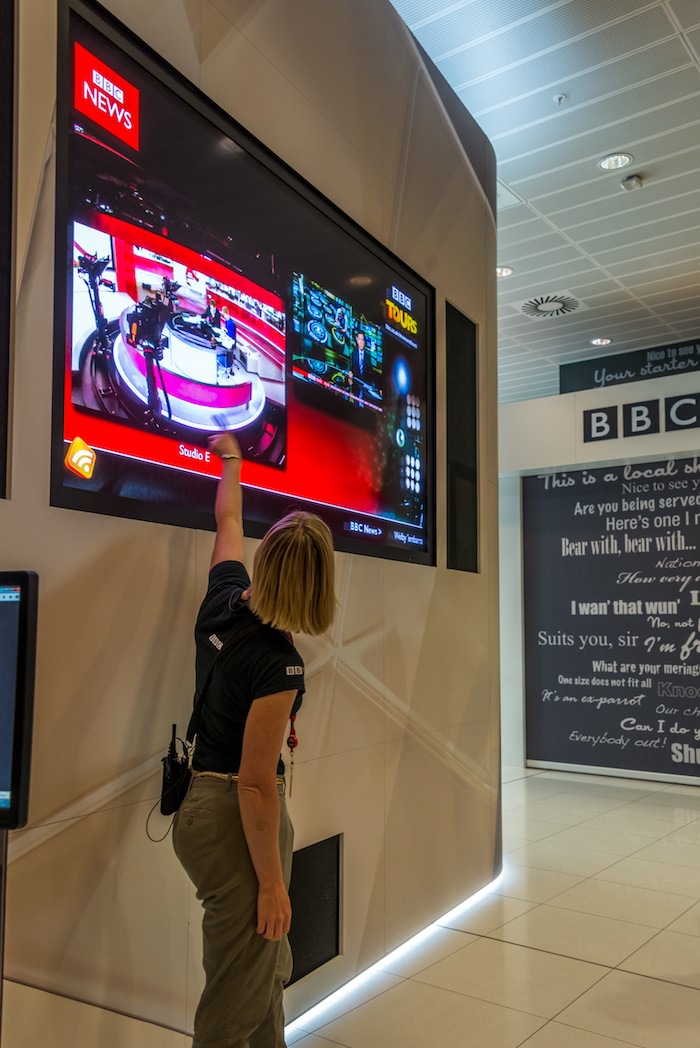
We learn about the new BBC Broadcasting House. Six thousand employees work here, of whom 2,200 are journalists.
Next we learn about the new BBC Broadcasting House. Six thousand employees work here, of whom 2,200 are journalists. The new broadcasting house took over a decade to complete, and cost 1,014 million GBP. It is part of a cost-saving strategy to consolidate the BBC’s properties, and will save the corporation more than 700million GBP over the remaining 21-year life of the BBC lease on Broadcasting House. The structure is 80,000 square meters, making it the largest newsroom in Europe.

The far end of the U-shaped courtyard, or Piazza, is lined with curved green glass, with revolving door beneath.
The BBC has a strong record of delivering complex and ambitious technology-enabled transformation projects such as the BBC iPlayer, High Definition on Freeview, and the digital Olympics. Under the Digital Media Initiative (DMI), the BBC tried to create new digital production tools and link them with a central digital archive that would allow BBC staff to access a seamless digital chain throughout the production process, from camera to archive. i.e. they could access all information from the same system and store them on a computer. But a report in 2012 showed that the DMI was not going to deliver its stated objectives, and the BBC Director-General, Tony Hall, closed the program down.
Then we move from the side room out into the lobby, to look down into News Hub, the main newsroom. This is a familiar sight, as we see it every time we watch the BBC News on TV. It’s filled with 350 journalists and technicians. The newsroom is huge, measuring about 40 yards long by 20 yards wide.
We look out over a series of 23 long, straight desks with about eight people sitting at each, and near the center, two large U-shaped desks. The people at each desk are teams for the BBC’s different divisions like entertainment, online, world service, radio news, photography department, parliamentary coverage, etc. The journalists are all bustling around, working at their computers, talking on the phone, or walking around. Visitors are not allowed to photograph the pit, for security reasons. Below this level, there are three more underground levels. They need special sprung floors to protect them from being shaken around by the vibrations from the underground railways that pass nearby.
We’re told that the BBC has deployment teams, ready to cover news at the drop of a hat. The corporation also has stringers on call around the world. And, interestingly, 85% of the news we see and hear is planned beforehand in the newsroom, with the remainder coming from sudden, late-breaking news, unexpected events and catastrophes.
Our second stop on the tour is a practice newsroom in a mock-up studio, adjacent to the front lobby. Here, we try our hand at reading the news and weather. Some of our group volunteers to read the news in front of a camera, while the rest of us watch and critique.
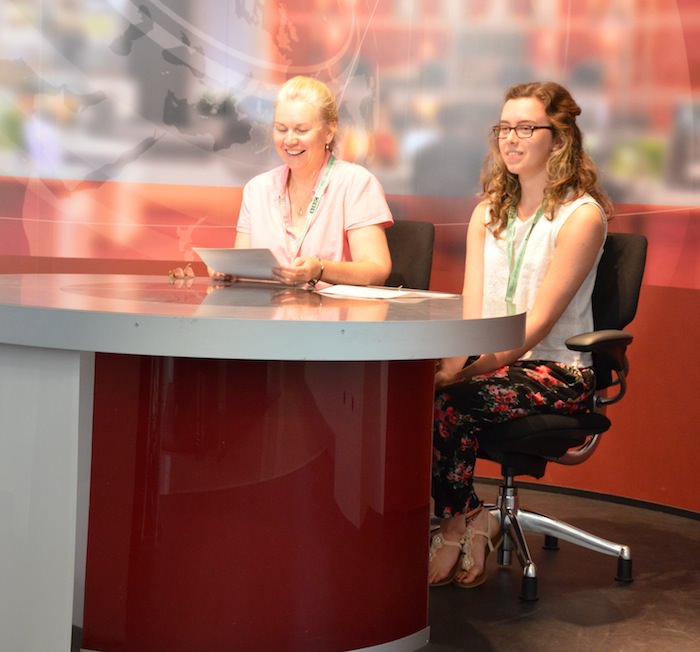
We try our hand at reading the news and weather. Some of our group volunteers to read the news in front of a camera, while the rest of us watch and critique.
Next, we walk outside to the cavernous Piazza, the entry courtyard to the BBC entrance. Small bronze plaques are inset into the concrete courtyard, memorializing places where atrocities and earth-shaking events have taken place in world history. We see the memorial to BBC reporters who have lost their lives around the world on duty. Our guide tells me that up until 2008, 1,000 reporters (from all media) have lost their lives in the previous ten years, doing their job—an average of 2 killed each week.
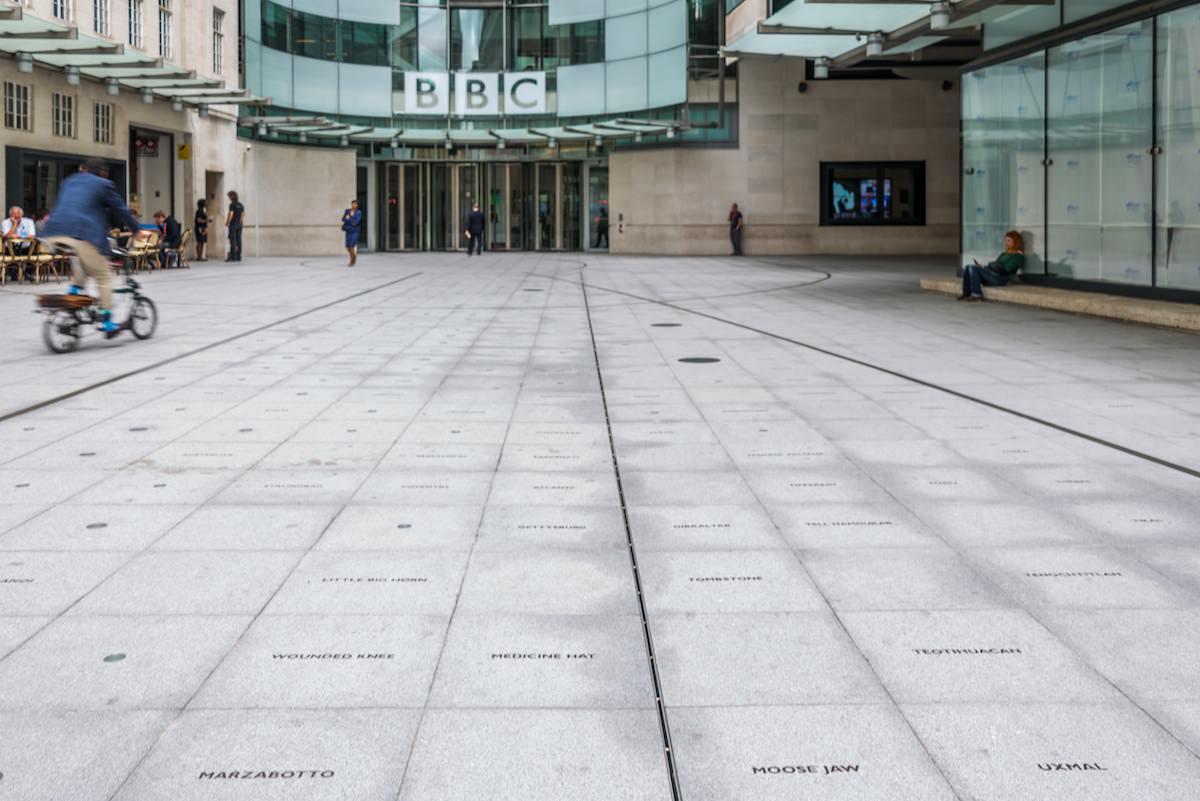
The entry courtyard to the BBC entrance. Small bronze plaques are inset into the concrete courtyard, memorializing places where atrocities and earth-shaking events have taken place in world history.
The third section of our tour is in the Old BBC building that forms a wing to the Piazza. Dating from 1932, this art deco fronted building has statues of Prospero and Ariel, from Shakespeare’s ‘The Tempest’, set above the entrance.
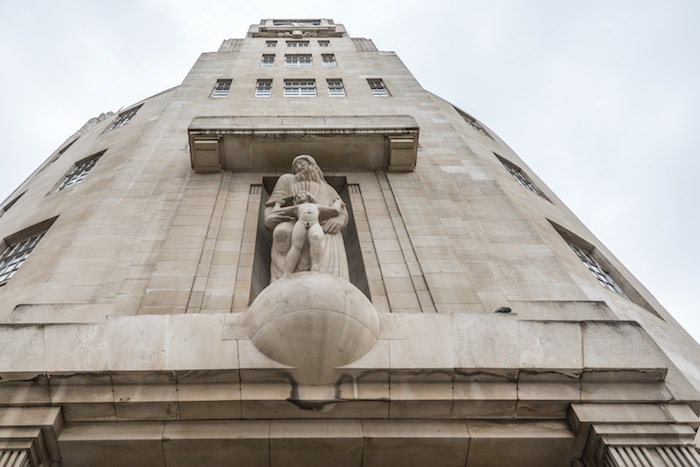
The Old BBC building that forms a wing to the Piazza. Dating from 1932, this art deco fronted building has statues of Prospero and Ariel, from Shakespeare’s ‘The Tempest’, set above the entrance.
Inside the lobby of the Old Building, we see a timeline of major BBC news events. Some noteworthy events follow:
- 1963. Dr. Who TV series started. This is the world’s longest running sci-fi TV series.
- 1983. Breakfast TV shows started.
- 1995. Digital audio broadcasting begins.
- 1997. BBC channel news goes on air 24/7.
- 2011. Wimbledon tennis is first shown in 3D.
- 2012. First digital (London) Olympics aired.
The Old Building is now used primarily for radio shows, with some live telecasting. We also learn that the British Prime Minister writes the Queen’s speeches. Who knew?
Part four of the tour is “backstage” in a dressing room. Still in the Old BBC Building, we visit the dressing room where celebrities like Rod Stewart, Bon Jovi, Robbie Williams, prepare for shows in the BBC Concert Theater.
The fifth section of our tour is the Old BBC Radio Theater, that seats 400 people. It was used as a bomb shelter from the German bombing raids in World War II. A German bomb hit the seventh floor of BBC House in World War II that finally settled on the second floor. The announcer paused briefly, then carried on with his news reading. The bomb exploded 57 minutes later, and no one was hurt due to evacuation.
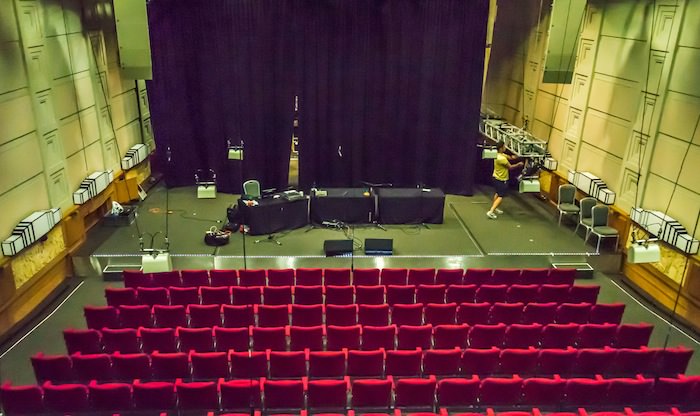
The Old BBC Radio Theater, that seats 400 people. It was used as a bomb shelter from the German bombing raids in World War II.
Out tour ends in the Production Theater in the Old BBC Building. We create our own radio play, complete with music and sound effects. We’re given a script for the interactive play and a few minutes’ instructions on our roles in the play. Then we’re turned loose. Considering that we’re an uninitiated group, the resulting play was quite good, and very funny as we watched each other play acting our roles.
Our fascinating tour ends here. Nearly 50,000 people have taken the tour already, since March 2013. All in all the BBC Broadcasting House Tour is fun, interesting, and informative—a must for radio and TV heads.
Tour Details:
Tour available seven days/week.
BBC Broadcasting House
Portland Place
London W1A 1AA
You must book the tour in advance at: BBC Shows and Tours
Adults £13.50
Concession £11.25
Students £10.00
Children (between 9 and 15 years) £9.00
No babies or children under 9.
Family ticket 39.
Disabled access available.
Written by and photos by Roy Stevenson for EuropeUpClose.com


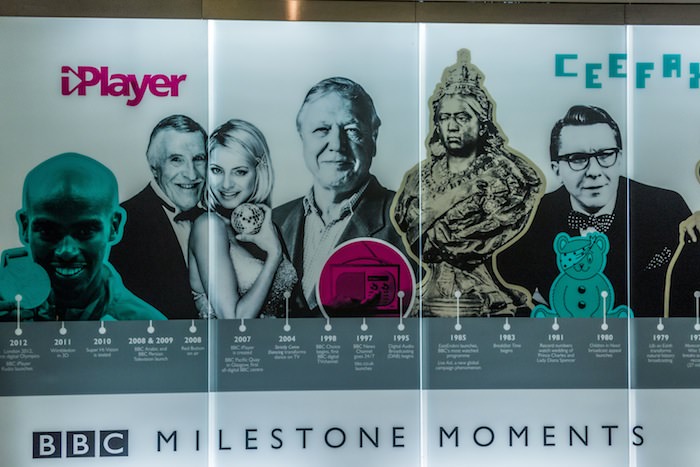

Roy Stevenson
Monday 15th of August 2016
Ollie, Many thanks for this update. Much appreciated! Regards, -Roy Stevenson
JAKE
Tuesday 23rd of September 2014
VERY WELL DONE. THANK YOU!